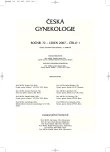TVT SECUR System – Tension-free Support of the Urethra in Women Suffering from Stress Urinary Incontinence – Technique and Initial Experience
Authors:
A. Martan; J. Mašata; K. Švabík
Authors‘ workplace:
Gynekologicko-porodnická klinika VFN a 1. LF UK, Praha
přednosta prof. MUDr. A. Martan, DrSc.
Published in:
Ceska Gynekol 2007; 72(1): 42-49
Category:
Original Article
Overview
Objective:
The aim of the article is to present a new, minimally invasive sling procedure for the treatment of the stress urinary incontinence in women – the TVT S System (tension-free vaginal tape secure system).
Design:
Cross-sectional clinical study.
Settings:
Gynecological and Obstetric Clinic, 1 LF UK and VFN, Prague.
Materials and Methods:
We present the technique employed in the operation, the examination procedure including US examination before and after the operation, at rest and during Valsalva manoeuvre, and the subjective and objective outcome in our group. This study is intended to determine the curative effect and the complications associated with TVT S procedure. The clinical study included 15 women with previously untreated stress urinary incontinence. Their mean age was 53.1, mean body mass index (BMI) 27.73, and mean parity 1.86. The tape was placed ten times in a “Hammock” position and five times in a “U”position.
Results:
All patients are between one and three months after the operation. The curative rate is 93%. The complications of the TVT S are as follows: when the tape was placed in the “Hammock” position, in one case slight SUI (stress urinary incontinence) persisted; the tape was folded in two cases; one patient suffered from pain in the vagina after this procedure. In one case we found vaginal erosion caused by the tape; the size of the erosion was about 3 mm. We did not find any complications after TVT S procedure when the tape was placed in the “U” position.
Conclusions:
Our experience with TVT S procedure including possible complications, postoperative care and curative rate is positive. TVT S with two approaches “U” and “Hammock” gives us one tool for both main groups of patients with SUI. In the group of patients with larger mobility of the urethra it might be better to place the tape in the “Hammock” position: this procedure is simpler and quicker. In the group of patients with less mobility of the urethra it seems that to use the tape in the “U” position is the better option, this procedure is longer and slightly more difficult.
Key words:
female urinary incontinence, complications, TVT Secur system
Labels
Paediatric gynaecology Gynaecology and obstetrics Reproduction medicineArticle was published in
Czech Gynaecology

2007 Issue 1
Most read in this issue
- Choroid Plexus Cysts and Risk of Trisomy 18. Modifications Regarding Maternal Age and Markers
- Efektivita měření nosní kosti jako UZ markeru pro Downův syndrom v 11.-13+6. týdnu gravidity
- Ovarian Hypertimulation Syndrome: a Review
- Laparoscopic Myomectomy: Indications and Limits
